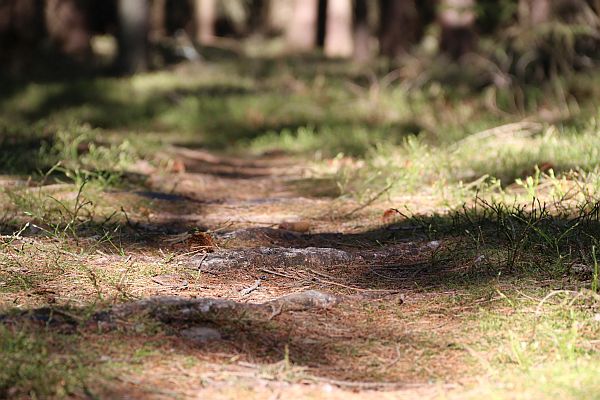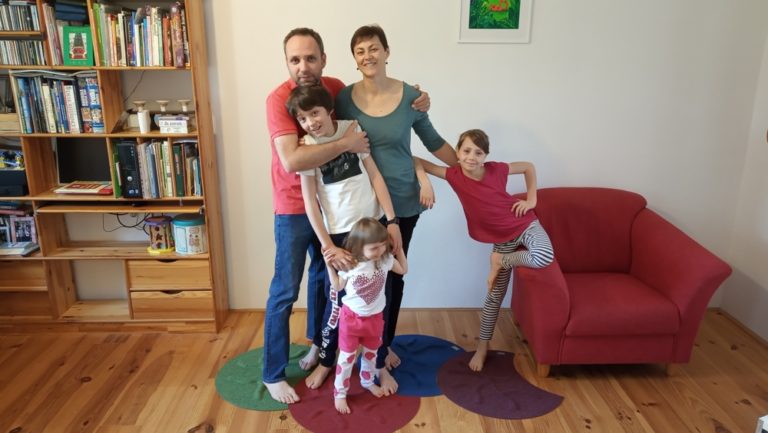Our Story
It all started with a toe
 It actually happened by chance. While treating some excezma on our son’s feet, my wife noticed something. His big toes were slightly crooked.
It actually happened by chance. While treating some excezma on our son’s feet, my wife noticed something. His big toes were slightly crooked.
We had seen this before, with my son’s grandmothers. They both wore narrow, pointy shoes all their lives. But how could it happen to a little boy?
Is it shoes? Or some problem with his feet? We visited a doctor. He referred us to an podiatrist. The podiatrist gave us two options: either let it be and wait for the foot to develop, or try orthopaedic insoles.
Let it be? That seemed irresponsible to us. But inserts? It didn’t seem like a real solution.
Did we just want to support the feet, or did we want to strengthen them?
What is wrong with that leg? If it needs an insole to support it, doesn’t that mean it’s weak? Why not strengthen it and let it heal itself? After all, when your leg comes out of a plaster cast, it doesn’t need a splint. It needs exercise!
We decided to give it a try. Intuition told us we wouldn’t do any harm if we did. We were lucky to find a willing physiotherapist who understood us. She showed our son some effective exercises, which we then practiced with him regularly for about 2 weeks.
But over time the exercise became too hard to maintain. You try doing boring exercises regularly with a four-year-old! We slowly lost hope that our son would have healthy legs, and resigned ourselves to orthopedic insoles.
Awakening in the Sumava Forest
 But there was a thought that I just could not get out of my head. Nature wants our feet to work for us our whole lives. And they do! We can walk, run, jump, even climb with our feet.
But there was a thought that I just could not get out of my head. Nature wants our feet to work for us our whole lives. And they do! We can walk, run, jump, even climb with our feet.
It all came to us on a day trip in the Bohemian Forest. We chose, for once, not the flat and easy road above, but the forest path, full of rocks, pine needles, streaky roots and soft clay. It was on such a surface that humans usually moved before perfectly leveling the surfaces in their dwellings, I thought. And they were barefoot.
The problem is not the leg. It is the surface on which it moves
 No, the problem wasn’t really in my son’s legs. It wasn’t about his abilities at all. All his feet needed was an opportunity. They needed a surface that was a little uneven, but varied. A surface that would expose them to stimuli, where they could flex and grow stronger.
No, the problem wasn’t really in my son’s legs. It wasn’t about his abilities at all. All his feet needed was an opportunity. They needed a surface that was a little uneven, but varied. A surface that would expose them to stimuli, where they could flex and grow stronger.
The foot is an organic structure. All the tendons, muscles and joints are only as strong as they need to be. Therefore, a strong foot requires stimuli, it needs to respond to the variable nature of the surface. Today, this knowledge still feels like a miracle. And I never expected anything like this to change my life.
Barefoot (but just in the garden)
 We have a small garden at our house. Although there are no stones or roots, it is still a varied and uneven surface. We started there. Our whole family – me, my wife, my son and my daughter – started to walk barefoot in the garden. The children had no problem at all, on the contrary. They enjoyed discovering the world with their feet.
We have a small garden at our house. Although there are no stones or roots, it is still a varied and uneven surface. We started there. Our whole family – me, my wife, my son and my daughter – started to walk barefoot in the garden. The children had no problem at all, on the contrary. They enjoyed discovering the world with their feet.
But it was just a garden. You can’t be there all the time. My son started attending a kindergarten where there were (of course) obligatory slippers. He spent most of his time there. Children were not even allowed to play without shoes in the school garden.
“Don’t run barefoot! You will step on a stone and it will hurt you! ”The teachers called out to them.
Barefoot walking brings results, but it is difficult
Too bad, I thought. Too much protection robs children of precious stimuli and the desire for new life experiences. So our son walked barefoot in our garden, but only when the weather allowed.
We were annoyed that someone or something was constantly hindering our efforts. But we were increasingly convinced that we were doing a good thing. Slowly but surely, his feet began to improve.
Our home is where we walk most of time. We have to make it uneven there
 Sometimes necessity (and despair!) is the mother of invention. One evening while I was sitting in the garden on our garden swing chair I asked myself: why couldn’t we bring those stones and roots to our home? To where we live, where our children stay and move most?
Sometimes necessity (and despair!) is the mother of invention. One evening while I was sitting in the garden on our garden swing chair I asked myself: why couldn’t we bring those stones and roots to our home? To where we live, where our children stay and move most?
That’s when things started. I sacrificed our larger doormat, and glued everything I found at home to it using a melting gun. And the first sensomotoric rug was born!
I won’t lie: it was pretty weird. A UFO, made of wooden wheels from an old broken toy, pieces of hemp rope and other strange materials.
Nevertheless, I placed the rug in the children’s room and waited. The children were thrilled (and so was I).
It worked! The children walked along, training their feet with each step. But the joy lasted only until pieces began to fall off the mat.
I wasn’t downhearted. The bumpy rug just needed to be made nicer and safer.
We’re not alone
We have a lot of friends and acquaintances with whom we often discuss parental issues. When we mentioned our son’s feet, it turned out that we weren’t the only ones to have noticed the problem. Almost all the children from our neighborhood had weakened feet.
In fact, this is no mystery, I thought. It is the lifestyle we share. Flat floors, slippers… it’s the same in all our houses.
30 prototypes for the root carpet
So I started making prototypes of bumpy rugs and lent them to our friends for testing. I made more than 30 of them.
Gradually we worked our way to the final materials and also to the types of bump. The roots seemed to work the best, making every step a different exercise, just like in the Sumava Forest. Moreover, they look so good that I have never been ashamed of my carpet again.
The roots work
 We’ve solved the problem of my son’s big toe. But nothing is forever. Not only children’s but also adults‘ legs need constant stimulation to maintain their strength, flexibility and health throughout their lives.
We’ve solved the problem of my son’s big toe. But nothing is forever. Not only children’s but also adults‘ legs need constant stimulation to maintain their strength, flexibility and health throughout their lives.
That’s why we made the root carpet to serve the whole family and become a natural part of the human dwelling. Because we want to give feet a chance.
Viktor – father, husband, founder of Rooty.
